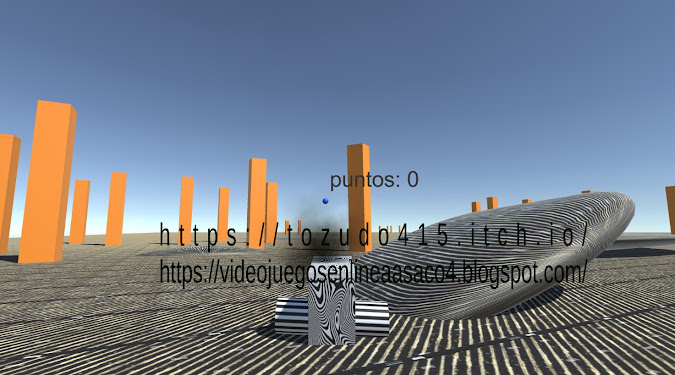using System.Collections.Generic;
using UnityEngine;
public class ALKLICARRATONNIVEL1 : MonoBehaviour
{
void Start () {
}
void Update () {
if (Input.GetButton ("Fire1"))
{
Application.LoadLevel (1);
}
}
}

Estoy probando hacer videojuegos para poderlos jugar desde teléfonos móviles, con los navegadores de internet que tienen la mayoría, este ejemplo que quiero trabajarme lo funciona en los pc con Windows y el mouse y en los teléfonos con el tacto del dedo, se puede giar y se puede disparar con el dedo tocando la pantalla, tiene un script para que el cubo se mueva solo y otro para que pueda inclinar lo y así frenarlo o darle marcha atrás , aparte al dar toques en la pantalla se producen los disparos, derribamos unos pilares y recogemos unas capsulas para sumar puntos….apartir de hay lo que se me ocurra y lo que la memoria de mi teléfono aguante,,,,en fin iré haciendo y comentando...pongo los scripts en C# que utilizo y el juego esta echo con Unity…
using System.Collections;
using System.Collections.Generic;
using UnityEngine;
public class muebeladodespacio : MonoBehaviour {
// Use this for initialization
void Start () {
}
// Update is called once per frame
void Update () {
transform.position += transform.forward * 1.2f * Time.deltaTime; }
}
😁😁😁😁😁😁😁😁😁😁😁😁😁😁😁😁😁😁😁😁😁😁😁😁😁
😁😁😁😁😁😁😁😁😁😁😁😁😁😁😁😁😁😁😁😁😁😁😁😁😁
😉😉😉😉😉😉😉😉😉😉😉😉😉😉😉😉😉😉😉😉😉😉😉😉
using System;
using UnityEngine;
using UnityStandardAssets.CrossPlatformInput;
namespace UnityStandardAssets.Utility
{
public class SimpleMouseRotator : MonoBehaviour
{
// A mouselook behaviour with constraints which operate relative to
// this gameobject's initial rotation.
// Only rotates around local X and Y.
// Works in local coordinates, so if this object is parented
// to another moving gameobject, its local constraints will
// operate correctly
// (Think: looking out the side window of a car, or a gun turret
// on a moving spaceship with a limited angular range)
// to have no constraints on an axis, set the rotationRange to 360 or greater.
public Vector2 rotationRange = new Vector3(70, 70);
public float rotationSpeed = 10;
public float dampingTime = 0.2f;
public bool autoZeroVerticalOnMobile = true;
public bool autoZeroHorizontalOnMobile = false;
public bool relative = true;
private Vector3 m_TargetAngles;
private Vector3 m_FollowAngles;
private Vector3 m_FollowVelocity;
private Quaternion m_OriginalRotation;
private void Start()
{
m_OriginalRotation = transform.localRotation;
}
private void Update()
{
// we make initial calculations from the original local rotation
transform.localRotation = m_OriginalRotation;
// read input from mouse or mobile controls
float inputH;
float inputV;
if (relative)
{
inputH = CrossPlatformInputManager.GetAxis("Mouse X");
inputV = CrossPlatformInputManager.GetAxis("Mouse Y");
// wrap values to avoid springing quickly the wrong way from positive to negative
if (m_TargetAngles.y > 180)
{
m_TargetAngles.y -= 360;
m_FollowAngles.y -= 360;
}
if (m_TargetAngles.x > 180)
{
m_TargetAngles.x -= 360;
m_FollowAngles.x -= 360;
}
if (m_TargetAngles.y < -180)
{
m_TargetAngles.y += 360;
m_FollowAngles.y += 360;
}
if (m_TargetAngles.x < -180)
{
m_TargetAngles.x += 360;
m_FollowAngles.x += 360;
}
#if MOBILE_INPUT
// on mobile, sometimes we want input mapped directly to tilt value,
// so it springs back automatically when the look input is released.
if (autoZeroHorizontalOnMobile) {
m_TargetAngles.y = Mathf.Lerp (-rotationRange.y * 0.5f, rotationRange.y * 0.5f, inputH * .5f + .5f);
} else {
m_TargetAngles.y += inputH * rotationSpeed;
}
if (autoZeroVerticalOnMobile) {
m_TargetAngles.x = Mathf.Lerp (-rotationRange.x * 0.5f, rotationRange.x * 0.5f, inputV * .5f + .5f);
} else {
m_TargetAngles.x += inputV * rotationSpeed;
}
#else
// with mouse input, we have direct control with no springback required.
m_TargetAngles.y += inputH*rotationSpeed;
m_TargetAngles.x += inputV*rotationSpeed;
#endif
// clamp values to allowed range
m_TargetAngles.y = Mathf.Clamp(m_TargetAngles.y, -rotationRange.y*0.5f, rotationRange.y*0.5f);
m_TargetAngles.x = Mathf.Clamp(m_TargetAngles.x, -rotationRange.x*0.5f, rotationRange.x*0.5f);
}
else
{
inputH = Input.mousePosition.x;
inputV = Input.mousePosition.y;
// set values to allowed range
m_TargetAngles.y = Mathf.Lerp(-rotationRange.y*0.5f, rotationRange.y*0.5f, inputH/Screen.width);
m_TargetAngles.x = Mathf.Lerp(-rotationRange.x*0.5f, rotationRange.x*0.5f, inputV/Screen.height);
}
// smoothly interpolate current values to target angles
m_FollowAngles = Vector3.SmoothDamp(m_FollowAngles, m_TargetAngles, ref m_FollowVelocity, dampingTime);
// update the actual gameobject's rotation
transform.localRotation = m_OriginalRotation*Quaternion.Euler(-m_FollowAngles.x, m_FollowAngles.y, 0);
}
}
}
😀😀😀😀😀😀😀😀😀😀😀😀😀😀😀😀😀😀😀😀😀😀😀😀😀😀😀😁😁😁
😊😊😊😊😊😊😊😊😊😊😊😊😊😊😊😊😊😊😊😊😊😊😊😊😊😊😊😊😊😊😊
using System.Collections;
using System.Collections.Generic;
using UnityEngine;
using UnityEngine.UI;
public class solosumar : MonoBehaviour
{
// Create public variables for player speed, and for the Text UI game objects
public float speed;
public Text countText;
public Text winText;
// Create private references to the rigidbody component on the player, and the count of pick up objects picked up so far
private Rigidbody rb;
private int count;/// <summary>
/// //////////////////////////////////////////
/// </summary>
//private int PUNTOS;/// <summary>
/// /////////////////////////////////////////////////
/// </summary>
// At the start of the game..
void Start ()
{
// Assign the Rigidbody component to our private rb variable
rb = GetComponent<Rigidbody>();
// Set the count to zero
count = 0;
// Run the SetCountText function to update the UI (see below)
SetCountText ();
// Set the text property of our Win Text UI to an empty string, making the 'You Win' (game over message) blank
winText.text = "";
}
// When this game object intersects a collider with 'is trigger' checked,
// store a reference to that collider in a variable named 'other'..
void OnTriggerEnter(Collider other)
{
// ..and if the game object we intersect has the tag 'Pick Up' assigned to it..
//if (other.gameObject.CompareTag ("ogri2"))
//if (other.gameObject.CompareTag ("mini"))
if (other.gameObject.CompareTag ("suma"))
//if (other.gameObject.CompareTag ("Terrain"))
{
// Make the other game object (the pick up) inactive, to make it disappear
//other.gameObject.SetActive (false);///////////////////////////////////////////////////////////////////////////////////////////////////////////////////////
// Add one to the score variable 'count'
count = count + 1;
// Run the 'SetCountText()' function (see below)
SetCountText ();
}
}
// Create a standalone function that can update the 'countText' UI and check if the required amount to win has been achieved
void SetCountText()
{
// Update the text field of our 'countText' variable
//countText.text = "Count: " + count.ToString ();
countText.text = "puntos: " + count.ToString ();
// Check if our 'count' is equal to or exceeded 12
//if (count >= 999)
if (count >= 5)
{
//Application.LoadLevel (1);
// Set the text value of our 'winText'
//winText.text = "COMPLETADO";
//TextMeshPro = "CAMPEON GANASTES";
//Destroy (gameObject, 1.2f); ////////////PROBAR TAPANDO ESTO
//Destroy (gameObject, 0.0f);
}
}
}
😛😛😛😛😛😛😛😛😛😛😛😛😛😛😛😛😛😛😛😛😛😛😛😛😛😛😛😛😛😛😛😛😛
😃😃😃😃😃😃😃😃😃😃😃😃😃😃😃😃😃😃😃😃😃😃😃😃😃😃😃😃😃😃😃




























